Project Management
My top choices for the best workflow automation software solutions are the following:
- Workato is best for enterprise security, admin, and support
- Zapier is best for workflow building
- UiPath is best for robotic process automation
- Make is best for workflow maintenance
- Pipefy is best for visual workflow editing
In this article…
What are the best workflow automation software solutions?
th, td {
padding: 5px;
}
| Star rating | Starting price | ||
| Workato | 3.72/5 | Custom pricing | Visit Workato |
| Zapier | 3.52/5 | $0 for up to 100 monthly tasks | Visit Zapier |
| UiPath | 3.47/5 | $0 for unlimited individual automation runs | Visit UiPath |
| Make | 3.40/5 | $0 for up to 1,000 monthly operations | Visit Make |
| Pipefy | 3.03/5 | $0 for up to five processes | Visit Pipefy |
May 3, 2024: Shelby Hiter rewrote the article to focus on workflow-specific software, which is why ClickUp, Jira, and Wrike no longer appear on this list. She then researched seven different platforms using an objective rubric, ultimately rewriting the article to focus on Workato, Zapier, UiPath, Make, and Pipefy as the top workflow automation software solutions. She also included in-depth information to explain the research and scoring methodology, as well as an updated final section about how to choose the best workflow automation software for your organization.
Our review is based on a rigorous scoring and evaluation methodology that focuses on the core features, capabilities, and other criteria that are most important to business users of workflow automation software. Before we began our actual scoring process, we looked at the overall workflow software market at a higher level, assessing more than 30 different software solutions across workflow automation, project management–specific workflow automation, and robotic process automation.
From there, we were able to narrow our actual evaluation to seven leaders in the workflow automation market:
- Zapier
- Make
- Kissflow
- Workato
- UiPath
- Pipefy
- Jitterbit
We evaluated all of these solutions based on seven broad categories of more than 50 subcriteria. Our research involved hands-on experience in each platform as well as thorough analysis of each vendor’s pricing and user reviews. Learn more about our core evaluation focus areas below.
Integrations: 25%
Our integration review process focused on the quantity, quality, and variety of integrations available to users since this is the most important aspect of any workflow automation software. The sheer volume of available prebuilt integrations was a large chunk of this score, but we also looked at the following:
- Availability of webhooks or coding features for custom integrations.
- Integrations for on-premises applications.
- App connection sharing.
- Allowlisting and app access restrictions.
Workflow building features: 20%
For the workflow building section of our assessment, we looked at several key factors that make the workflow design and implementation process run smoother for users of all backgrounds and skill levels. As far as accessibility goes, we paid close attention to:
- No-code and drag-and-drop editing capabilities.
- Quality and quantity of prebuilt recipes and project templates.
- In-app notes and collaboration features.
- AI-powered or RPA-powered assistance that supports more efficient and accurate builds.
We also looked for more advanced and powerful workflow-building features, including:
- Conditional branching or simultaneous actions.
- Custom forms.
- Custom actions and triggers.
- Custom fields.
- Custom API calls.
Workflow maintenance features: 20%
In the workflow maintenance piece of our evaluation, we looked at the built-in tools available to support administrators and other users who want a real-time, comprehensive glimpse at how workflows are performing and what improvements need to be made. We most heavily emphasized robust usage analytics and dashboards, but we also looked for the ability to set up real-time error monitoring and alerts and detailed version history logs and databases.
Security and enterprise administrative features: 10%
Security and administrative features are hugely important to enterprises that need to manage highly sensitive data and applications within the platform. With this knowledge in mind, we scored each tool based on the following features:
- User or group provisioning.
- Audit logs.
- Multifactor or two-factor authentication.
- Role-based permissions and access control.
- Single sign-on (SSO).
- API proxies.
- IP whitelisting.
At a user level, we looked at whether these tools allow guests and external users, and if so, how these users and their access are managed. We also considered how shared workspaces and project folders are organized and managed. Finally, we looked into each vendor’s security certifications and other security and privacy commitments to determine how well they would handle stricter compliance requirements.
Pricing: 10%
For pricing, we considered first and foremost how much value this product provides to its users across subscription tiers. We also assessed the overall scalability of each tool and the quality of their free subscription tiers, where applicable. Some vendors were unable to be direct with their pricing information, due to what they call an entirely tailored pricing structure that follows a case-by-case basis. In some instances, these vendors were docked due to the lack of pricing transparency.
Support: 10%
In this portion of our evaluation, we assessed the overall quality, usability, and availability of customer support. We looked at:
- Support hours.
- Multichannel support options (phone, email, ticketing, and/or chat).
- Self-service resources.
- Live training sessions.
- Community forums.
- Knowledge base articles.
User reviews: 5%
For the user review criteria, we researched how well each software solution was reviewed across third-party review sites. The sites we focused on include TrustRadius, Capterra, G2, and Gartner Peer Insights.
Workato: Best for enterprise security, admin, and support
Pros
- Excellent customer support
- Enterprise-level scalability and features
Cons
- No pricing transparency and no free plan
- SDK development work may be necessary for certain customizations.

Our Rating: 3.72/5
- Overall: 3.72
- User scores: 4.63
- Pricing: 1.25
- Support: 4.56
- Integrations: 3.81
- Workflow building: 3.63
- Workflow maintenance: 4.13
- Security and administration: 4.06
Workato is a leading enterprise workflow automation solution that is designed to support intelligent process automation for a variety of applications and use cases. The platform has more than 1,000 prebuilt integrations, public and private sharing options for connectors, various AI connectors and support tools, custom app connector options, and plenty of resources for on-premises workflows and apps.
Workato offers enterprise governance, security, and administrative features, which include high-quality audit logs, role-based access control, real-time monitoring, and usage analytics.
The tool also takes a collaborative approach, offering the Collaborators feature for human user management, API client management, and workplace management. With the Workato platform, users can effectively customize automation recipes and collaborate through in-app notes and comments on recipe steps.
Multichannel customer support is also available 24/7, which comes with unique support options like Product Hour presentations on various topics.
Workato’s biggest weakness is its lack of pricing transparency. However, although Workato is not very transparent with the actual numbers for its subscription prices, the plans themselves seem to be great for growing companies and use cases. Unlimited app and data connectivity, unlimited connections and recipes, unlimited builders and administrators, and other advanced features are included in all plans. Volume discounts are also available, particularly for users who use more than 1 million tasks, which is the minimum.
Custom and community connectors
Although Workato has an extensive collection of prebuilt connectors, it gives users access to a wide range of resources and tools to help them build their own. Depending on the design they choose, users can either share these custom connectors only within their organization’s workspace, or they can publicly share it with the Workato community.
With community connectors, Workato customers can easily learn more about the custom connector and its builder, its source code, what else has been built by that builder, and version history for that connector.
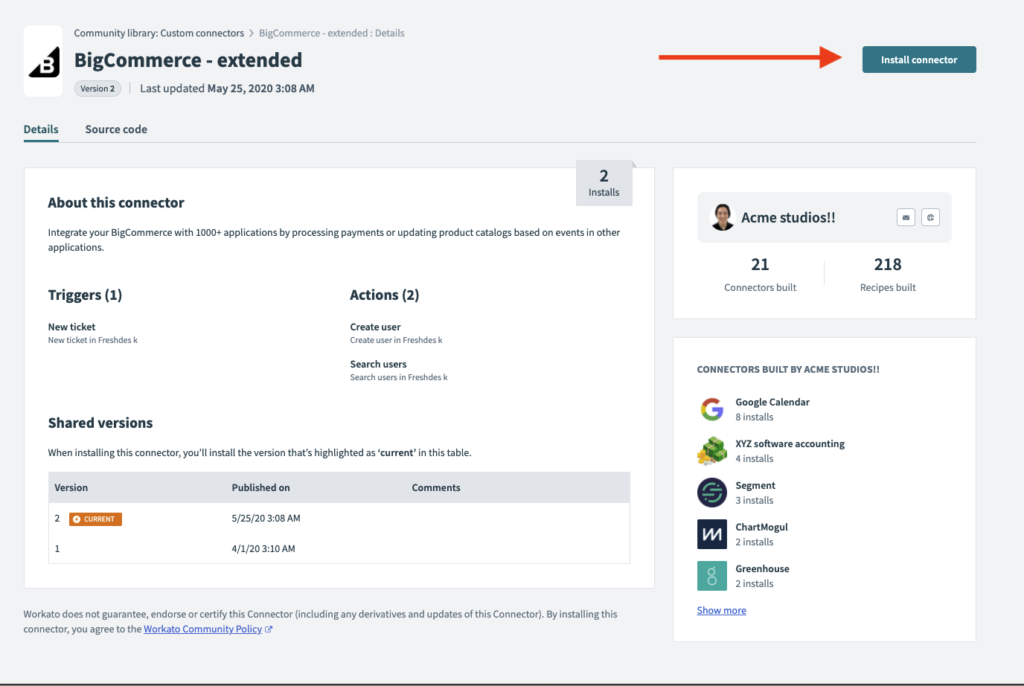
Role-based access control
Role-based access controls are both easy to use and highly customizable in Workato workspaces. For smaller companies or those that want to keep things simple, sticking with Workato’s three predefined roles—admin, analyst, and operator—might work better.
However, most organizations opt to create custom roles, which can be set up with highly granular permission sets across different tools and features for recipe development, platform tools, and admin privileges. These roles can be designated based on hierarchy, department or core responsibilities, or employee type.
Permissions range from full access to editing privileges to view-only privileges to no privileges at all. As your team grows and changes, roles can be cloned, deleted, and otherwise modified.
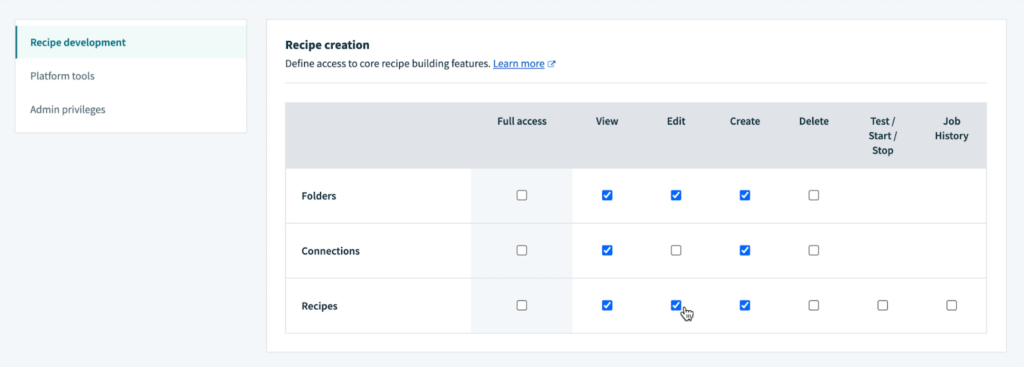
Workato does not disclose exact pricing details unless the user goes through the product demo and sales process, as prices are tailored to the exact needs of each customer. Business users must first select their preferred workspace and add tasks. Task count starts at 1 million, and volume discounts may be available for larger operations. Pricing may also look different for users who are interested in embedding Workato functionality directly into one of their products.
Hoping to get a little more information about how pricing works, I reached out to Workato’s support team and received the following response from an inbound SDR on their team:
“To keep it simple, there are two components to our pricing. The first is our annual platform fee. This includes unlimited users on our platform and access to over 2,000 pre-built connectors.
The second component is consumption-based. This increases as you add additional apps/workflows.
Because the price is so tailored to how our prospects decide to use it, we encourage them to take a scoping call where we can really delve into what they’re looking to do and then provide pricing from there.”
While this response did not provide me with much more additional detail, the representative responded to my query very quickly and thoroughly, which was appreciated.
I chose Workato because it’s a well-rounded and highly praised workflow solution that can handle enterprise-level automation needs.
The platform has received great user reviews, with some especially highlighting the quality of Workato’s customer support. Unlike most vendors in this space, Workato offers 24/7 support to all customers, with phone support and live chat as options. My own interactions with the Workato customer service team were prompt and thorough, even though I was not a subscribed user.
During my research, I found that Workato also had the most consistent and comprehensive security and admin features for its users. Top-tier audit logs, SSO, RBAC, and other enterprise security features are available; 2FA and just in time (JIT) provisioning are key parts of all plans; and extensive data compliance certifications are touted on the Workato website as a core part of their approach and architecture.
Combining these features with unique value-adds like the AI@Work suite of solutions, unlimited connections and recipes, unlimited builders and administrators, and tools to support on-premise applications and integrations, Workato can handle different types of workflow automation projects and support the needs of users with varying skill levels.
Zapier: Best for workflow building
Pros
- 6,000+ integrations available; more than nearly all competitors
- High levels of customizability in all tiers and at all skill levels
Cons
- Lacking usage analytics capabilities
- Limited security and admin features in lower tiers

Our Rating: 3.52/5
- Overall: 3.52
- User scores: 4.61
- Pricing: 3.75
- Support: 3.44
- Integrations: 3.50
- Workflow building: 4.75
- Workflow maintenance: 2.50
- Security and administration: 2.50
Zapier is one of the most popular workflow automation software solutions on the market—and for good reason. With more than 6,000 prebuilt app integrations and a variety of custom actions, triggers, and fields, Zapier’s scalability for nearly any business use case feels limitless.
Beyond its integration options and capabilities, Zapier stands apart from the crowd most when it comes to workflow-building features. Its automation templates and recipes are extensive, diverse, and available in all plans. The no-code workflow builder and visual editor are easy to use, even for users who have never worked with this type of software before. And the depth of customizable features, in-app collaboration capabilities, and AI-powered automations help this tool to scale as your team’s goals evolve.
In addition to more conventional workflow automation features, users can also benefit from multi-step actions and processing, version histories, and 2FA in all plans.
AI automations
A significant chunk of Zapier’s more than 6,000 prebuilt integrations and applications are AI-based, focusing on popular tools like ChatGPT, Gemini, Anthropic’s Claude, and Synthesia, among others. This unique capability allows users to set up workflows with their most-used AI tools and other business applications, which is particularly helpful for content generation and process management tasks that can benefit from a user not toggling between two different applications constantly.
In addition to these AI app connectors, Zapier also supports AI-powered automation via AI power-ups, AI-supported coding steps, and custom actions powered by AI. All of these AI automation features are available in all plans, including the free tier.
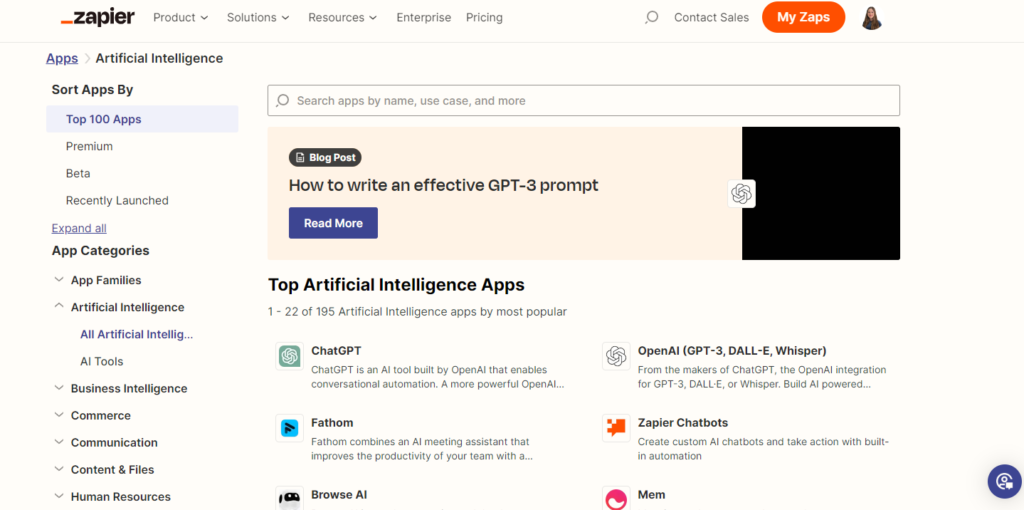
In-app collaboration and customizations
In-app collaboration is easy in Zapier. As you can see below, basic collaboration and communication are as simple as adding a note to any step in a workflow. Depending on the plan, Zapier users can also manage teams, organize projects into folders, share Zaps, and share app connections with other users.
All of these sharing capabilities are especially useful when taking advantage of Zapier’s high levels of customization. Users can collaborate on and make adjustments to custom actions, custom fields, and custom API calls in all Zapier plans.
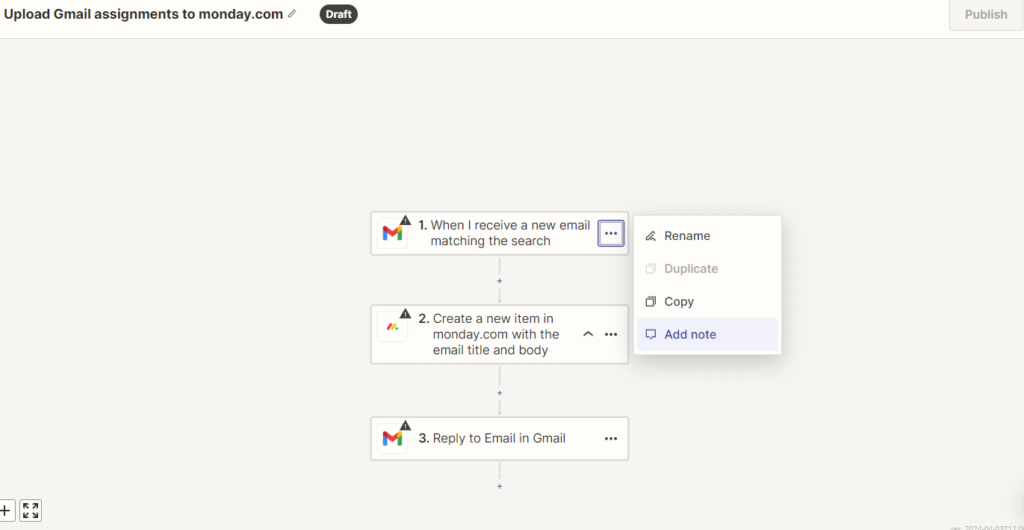
- Free: $0 for 100 tasks per month and access to Zaps, Interfaces (Basic), and Tables (Basic)
- Professional: Starts at $19.99 per month, billed annually, or $29.99 billed monthly. This plan requires users to sign up for at least 750 monthly tasks and goes up to 2 million monthly tasks (which costs $3,389 per month, billed annually, or $5,099 billed monthly). Custom limits beyond 2 million are available for interested users who contact the sales team.
- Team: Starts at $69 per month, billed annually, or $103.50 billed monthly. This plan requires users to sign up for at least 2,000 monthly tasks and goes up to 2 million monthly tasks (which costs $3,999 per month, billed annually, or $5,999 billed monthly). Custom limits beyond 2 million are available for interested users who contact the sales team.
- Enterprise: Pricing information is only available upon request. This plan version includes advanced admin and security features as well as more comprehensive customer support resources.
Zapier proved to be a reasonably priced and scalable workflow automation solution, though many features that may be necessary for teams managing corporate or sensitive data are only available in the highest product tiers. Additionally, users who go over their monthly task limits will be charged 1.5x more per each additional task needed in that billing period, which can quickly become expensive.
However, Zapier provides users with a generous free plan and is incredibly scalable, especially with the range of features already available in the lower-tier plans. Each plan tier offers reasonable upgrades with minimal upcharges from tier to tier.
I chose Zapier because it is a highly scalable solution that provides incredible prebuilt workflow integration options and customizability, meaning it will work for users of all skill levels and backgrounds.
Zapier far outpaces its competitors in the realm of prebuilt integrations, offering more than 6,000 options including modern AI applications like ChatGPT. Zapier keeps its catalog relevant and up-to-date, so even as business applications evolve and change over time, Zapier has the tools necessary to automate new workflows.
Although the free tier is limited to only one user, the features that the user can access are solid. I was impressed by my ability to access unlimited zaps and connections, automation templates and recipes, and AI power-ups and actions in my free account. Custom actions, triggers, fields, and API calls are also possible in all plans. However, additional points were docked for a pretty severe lack of useful analytics in the tool.
Zapier has received some of the best reviews in this sector, with reviewers frequently commenting on its ease of use and versatility. Its workflow-building tools are some of the best available, and what’s more, almost all of its workflow-building tools and capabilities are available in all plans. While some of the features can get a little overwhelming, I still had a fairly easy time setting up integrations that made sense in my free account.
UiPath: Best for robotic process automation
Pros
- Process and task mining for enterprise users
- Comprehensive automation tracking and management features, primarily through Orchestrator
Cons
- Limited number of prebuilt integrations and apps
- No 2FA or MFA access management capabilities

Our Rating: 3.47/5
- Overall: 3.47
- User scores: 4.38
- Pricing: 3.56
- Support: 3.81
- Integrations: 3.44
- Workflow building: 3.38
- Workflow maintenance: 3.50
- Security and administration: 2.81
UiPath is a robotic process automation and workflow automation tool that takes a unique, more hands-off approach to workflow automation. With the help of both attended and unattended robots, users can set up workflow automations for a variety of business cases. Tools like the built-in Orchestrator, Data Service, Test Manager, AI Center, and Insights all help users to deploy, monitor, manage, and update robotic workflows over time.
For teams that want to combine RPA with human-powered workflow automation, UiPath offers features to support this as well. For example, the platform has an Action Center, which is specifically designed to facilitate handoffs between robots and humans.
UiPath can work for either small, low-budget teams or high-powered enterprises, depending on which plan you select. For enterprises, on-premises solutions, process and task mining, multitenancy, and more advanced robots are all available to optimize UiPath’s capabilities.
Orchestrator for automation management
Orchestrator is UiPath’s primary automation management tool that can be used to manage the actions and work history of both attended and unattended robots. Even at an enterprise level, users can automate and monitor robotic automations, manage queues and assets, reference storage buckets and performance analytics, and take other steps to provision and deploy RPA. Regardless of which plan you select, Orchestrator is the ideal UiPath space for managing webhooks, custom connectors, parallel processes, and version history.
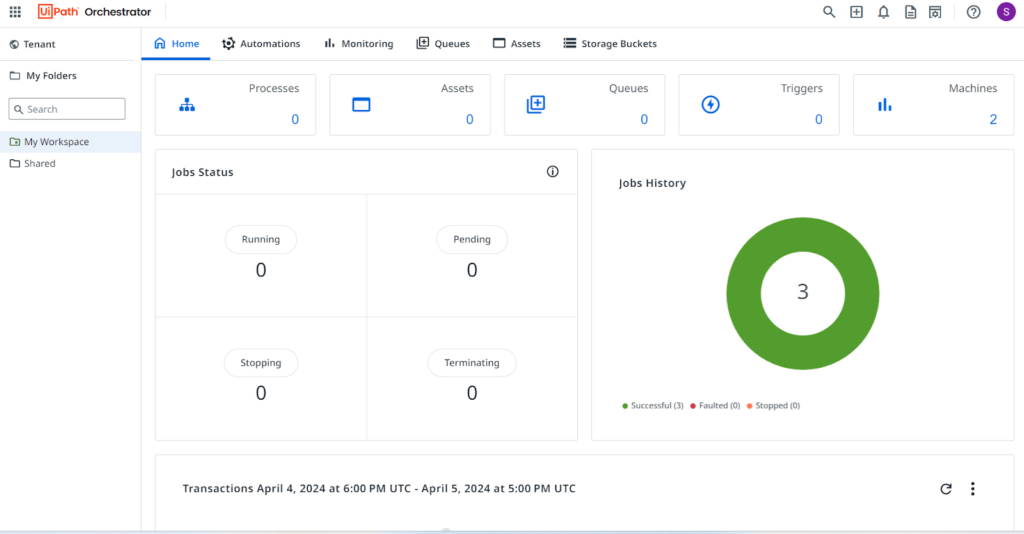
Robotic process automation
Depending on the plan you’re in, you can access attended robots, unattended robots, automation cloud robots, and test robots for more specific and complex automation projects.
Attended or supervised robots are available in all plans, including the free one. Unattended robots are available in all paid plans, allowing users to establish unattended robots that can automate workflows without much human intervention. Test robots are available in UiPath’s top two tiers.
These robots are great for enterprises that want a full lifecycle management process that can be monitored and tested before deploying into production.
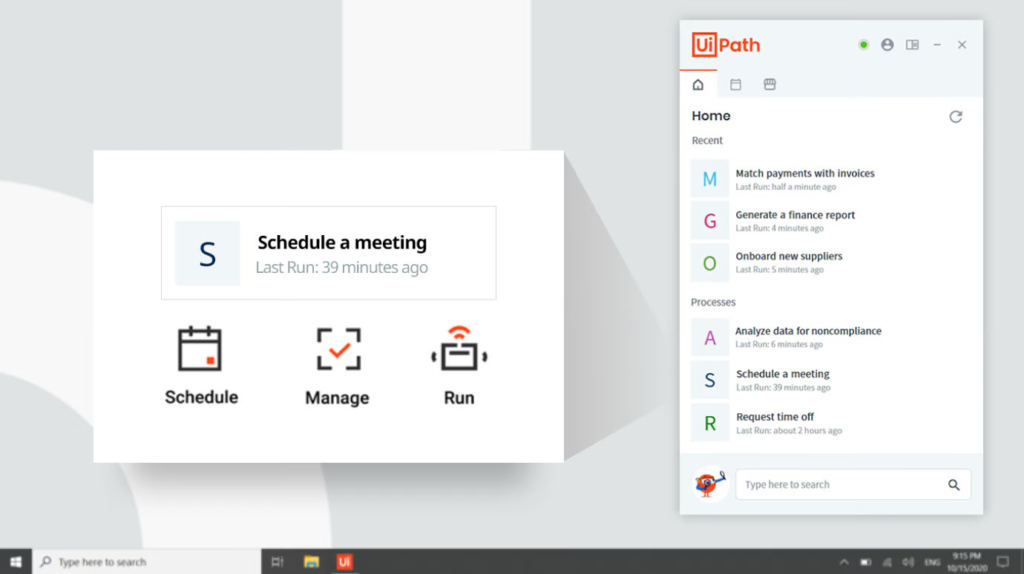
- Free: $0 for unlimited individual automation runs and limited access to other UiPath features
- Pro: Starts at $420 per month
- Enterprise: Pricing information available upon request
Additionally, there is the Pro Trial signup option, which includes more features than the Pro plan but fewer than the Enterprise plan.
I chose UiPath because it provides all of the conventional workflow automation features you’d expect from this type of tool but with helpful additions in the form of RPA. It also provides process and task mining capabilities in higher-tier plans, which enables a greater-than-normal ability to get down into the details of your tasks and optimize them.
Even with my free plan, I was able to take advantage of the Orchestrator tool and can say that it is a powerful assistant to its users, helping them to comprehensively visualize performance and manage both human-run and robot-run automations. The analytics in this section of the tool are impressive, getting down into usage details and into more specific information about assets, storage, and other factors that could impact workflow automation performance and longevity.
The only area that was somewhat lacking was the free plan, as it did not include any real access to customer support resources. I found myself circling through the platform, trying to find any way to get in touch with the support team for simple questions, but this proved ineffective.
While this certainly docked UiPath’s overall score, the free plan still has many redeeming and useful qualities. Webhooks and custom connectors are available in all plans, the capable Integration Service is fully available to all users, and comprehensive security and admin features like RBAC and audit logs are part of every plan.
In my personal opinion, this tool is a little overwhelming for inexperienced or less-technical users, but for the right team and skill sets, UiPath is one of the best options for the utmost scalability.
Make: Best for workflow maintenance
Pros
- Comprehensive tools for monitoring and managing workflow automation performance
- Unlimited users in free plan with generous automation quantities at each plan level
Cons
- Limited customer support resources outside of enterprise tier plans
- Customizations are limited in lower-tier plans

Our Rating: 3.40/5
- Overall: 3.40
- User scores: 4.73
- Pricing: 3.94
- Support: 2.00
- Integrations: 2.81
- Workflow building: 3.19
- Workflow maintenance: 4.88
- Security and administration: 2.50
Make, formerly known as Integromat, is a workflow automation and workflow management solution that helps users design custom workflows for a variety of apps and business projects. Make is best known for its user-friendly, no-code interface as well as its array of workflow maintenance solutions.
Users are particularly impressed with Make’s real-time error monitoring and alerts, parallel scenario execution, and version history features, which are each available in all plan tiers, including the free plan. Users also appreciate Make’s approach to usage analytics, with a My Organization dashboard that includes multiple tabs to look at different kinds of metrics.
Make is an all-around solution for workflow lifecycle management and automation, and it works well for users who want a collaborative platform for unlimited users. The company also frequently updates the tool and sources feedback from its users to improve its offerings.
Usage analytics
For a platform that is otherwise fairly simple compared to competitors, Make provides users with one of the most detailed and useful organizational dashboards for usage analytics. In the My Organization section of the Make platform, users can toggle between tabs for organization, teams, users, subscription, payments, installed apps, variables, and scenario properties data. The organization section is particularly straightforward and useful, giving users clear information about their current subscription tier, active scenarios, percentage of operations used, and percentage of data transfers used, among others.
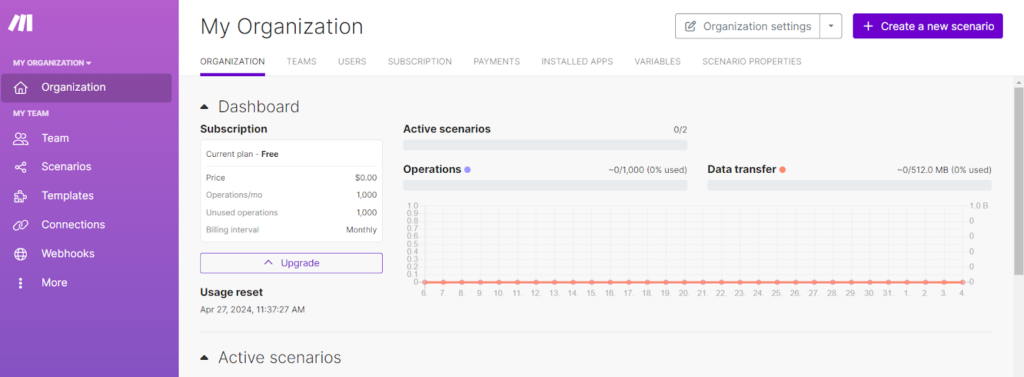
Webhooks
Webhooks are available and easy to set up regardless of which Make subscription plan you select. The interface for webhooks integrations is highly visual, not only showing the connections that are in place via a diagram but also providing information about operations history, any incomplete executions from past operations, and which operations are currently running. All users have the option to execute simultaneous operations and processes through webhooks.
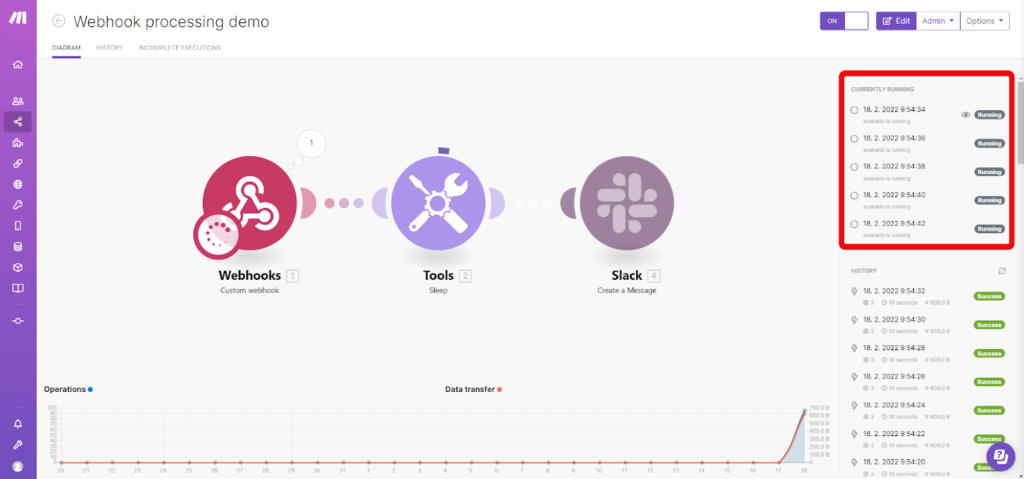
- Free: $0 for unlimited users to use up to 1,000 operations per month
- Core: Starts at $9 per month, billed annually, for 10,000 ops per month, or $10.59 billed monthly for the same number of ops. This plan’s pricing raises in intervals based on how many monthly operations you require. It can go up to 2 million ops per month, which would cost $988.28 if billed annually or $1,162.68 if billed monthly. A higher number of monthly operations may be available upon request.
- Pro: Starts at $16 per month, billed annually, for 10,000 ops per month, or $18.24 billed monthly for the same number of ops. This plan’s pricing raises in intervals based on how many monthly operations you require. It can go up to 2 million ops per month, which would cost $1,377.67 if billed annually or $1,620.79 if billed monthly. A higher number of monthly operations may be available upon request.
- Teams: Starts at $29 per month, billed annually, for 10,000 ops per month, or $34.12 billed monthly for the same number of ops. This plan’s pricing raises in intervals based on how many monthly operations you require. It can go up to 8 million ops per month, which would cost $8,231.05 if billed annually or $9,683.59 if billed monthly. A higher number of monthly operations may be available upon request.
- Enterprise: Pricing information available upon request for 24/7 customer support. This plan includes more advanced security and admin features and other unique enterprise-level features.
I chose Make because it is one of the best workflow automation deals on the market, especially for free plan users.
The free plan supports unlimited users and 1,000 automation operations per month. This makes the tool a great choice for a larger team that wants to experiment with their options, or even for a startup that has just begun setting up enterprise workflows.
With access to 1,739 prebuilt integrations, universally available webhooks, and great conditional branching and logic, this tool works well for teams that need to build complex integration and workflow structures for their business.
Make’s workflow maintenance features are truly some of the best today, with users frequently praising the quality of its error monitoring and alerts features as well as its AI assistant (currently in Beta) and its usage analytics. I was particularly impressed with the My Organization dashboard; even in my free-tier subscription, I was able to easily review a variety of data points like system-wide usage and performance, installed apps, variables, and scenario properties.
From where I sit, Make seems to be progressing and advancing its tool quickly and in a direction that will be favorable for businesses that care about digital transformation. With its AI assistant already working well in Beta, its recent replacement of the legacy Integromat, and the company’s commitment to crowdsourcing feedback from users, I expect this platform will continue to improve and rise through the ranks.
Pipefy: Best for visual workflow editing
Pros
- Special plan and discount system for small businesses
- Highly visual, project-management-style workflow management interface
Cons
- Several workflow building and customization features are actually offered through Workato, not Pipefy directly
- Incredibly limited free plan features

Our Rating: 3.03/5
- Overall: 3.03
- User scores: 4.38
- Pricing: 3.63
- Support: 3.44
- Integrations: 1.75
- Workflow building: 4.19
- Workflow maintenance: 2.75
- Security and administration: 2.75
Pipefy is a workflow and business process automation solution that focuses on form just as much as function. The platform is designed with a Kanban interface—very similar to Trello—so each card and subfield can be quickly visualized and customized to meet project demands. The platform is filled with prebuilt templates and forms, divided by industry and use case, allowing users of all backgrounds to quickly build workflows even with no experience.
This platform is designed for businesses of all sizes, but it’s important to note that the free plan is incredibly limited. While working with my own free account, I ran out of space almost immediately and before I had actually built a true workflow. Keep this in mind if you’re operating on a strict budget, though most user reviews indicate that lower-tier paid plans are reasonably priced.
Standout features in Pipefy include a customer success manager for all paid plan subscribers, guest and external user access, unlimited users in all paid plans, an AI copilot, and a shared workspace on all tiers. For the shared workspace, there does not seem to be a way to share notes with other users, which may inhibit in-app collaboration. However, RBAC and pipe settings make it so you can granularly adjust each card in each pipe. The email settings may also make it so you can send notes and notifications to users, though external to the platform.
Kanban view
Similar to many of the most popular project management software solutions and platforms, Pipefy improves its user interface with visual project views like the Kanban view. This view helps users to easily get an overarching view of how their workflows are progressing, where any bottlenecks may be developing, and where additional details about deadlines or stakeholders may need to be added.
Pipefy’s Kanban view is incredibly customizable, with options to set up custom fields and task information. Users can also easily drag and drop project components and edit from the Kanban view with no coding or developer actions required.
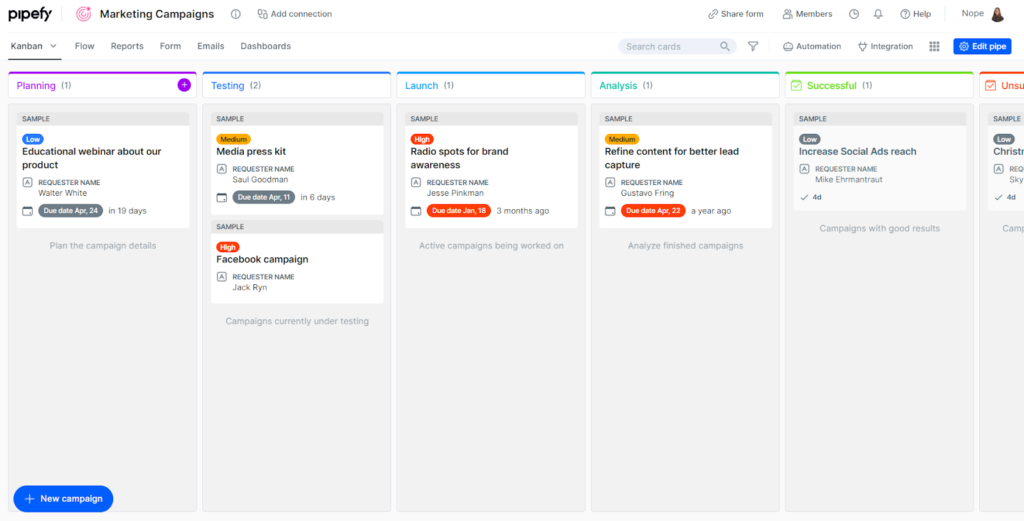
Project templates
Pipefy’s template gallery includes a mixture of project templates for easier workflow and form setup. The primary categories for templates cover business operations, finance, human resources, IT, and procurement. Within those categories, users can find highly detailed templates that focus on common use cases like sales pipelines, accounts payable, recruitment and hiring, customer support and help desk workflows, and more. These templates not only give users a basic skeleton to work with but also include tasks, subtasks, and other granular details that can help teams build out comprehensive, detailed processes with little to no experience with workflow management.
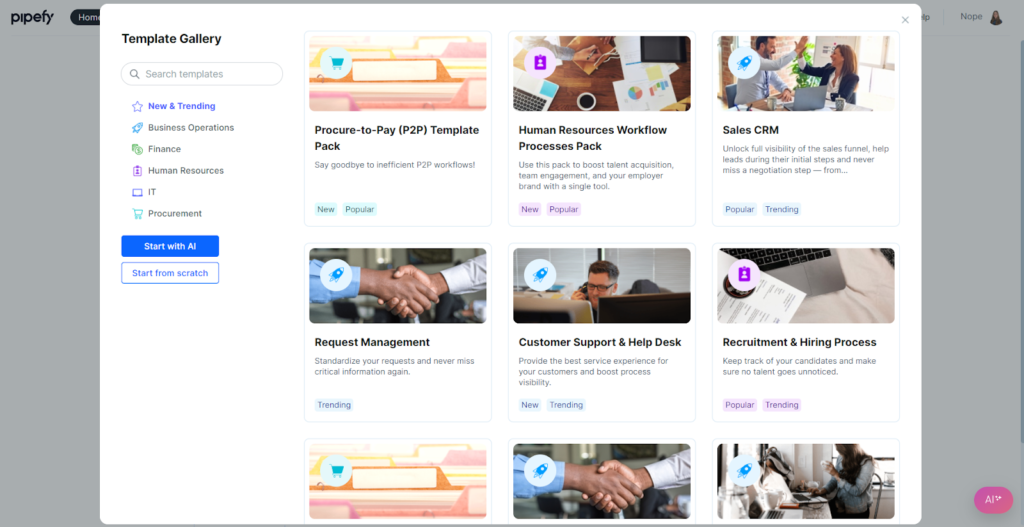
- Starter: $0 for up to 10 users to access up to five processes and other limited features
- Business: Pricing information only available upon request. This plan includes unlimited users, unlimited processes, and other more advanced features.
- Enterprise: Pricing information only available upon request. This plan includes integrations, multiple automations, and more advanced security and admin capabilities.
- Unlimited: Pricing information only available upon request. This plan includes unlimited automations, unlimited data storage, and other enterprise-level features.
- Special Plan for Small Businesses: Qualified businesses with 11 to 200 employees can access all product features at a 90% discount, presumably discounted from the typical cost of the Unlimited plan.
I chose Pipefy for this list because it is an incredibly approachable workflow automation solution.
Its Kanban interface is key here, making it so users don’t have to know how to code or connect their workflows to make them work. If you have a basic grasp of how you want your processes to run or even if you’ve used a PM platform like Trello, Pipefy will help you build the “pipes,” custom cards, and subfields necessary to create an effective workflow automation setup.
I also selected this tool because, unlike many other workflow automation platforms that focus solely on enterprise needs and budgets, Pipefy does a great job of creating unique value-adds for smaller businesses and teams. I was especially drawn in by the tool’s special plan for small businesses, which gives eligible companies up to a 90% discount on enterprise-level features.
I also appreciate the company’s weekly office hours approach that makes customer service more accessible to all and their commitment to providing all paid plan users with a dedicated customer success manager.
Finally, I selected Pipefy over many other leaders in this field because of its strategy for guest and external access. It is one of the few platforms that effectively support administrators with an easy way to add both company guests and external guests, who can have forms shared with them regardless of the plan you select.
How to choose the best workflow automation software for your business
While we recommend all the workflow software solutions above, the best one for your business depends on your unique situation. When deciding on what tool to use, it is important that you know what you need. Whether you’re looking to develop hands-off automations through RPA or simple workflows to improve your marketing and CRM setup, different tools are available to address these use cases and more.
Based on our evaluations, these are the best tools to choose for the following situations:
- Choose Workato if you want an enterprise-grade, scalable solution that comes with all the bells and whistles, particularly for security, administrative, and support features.
- Select Zapier if your top priority is a large and diverse library of prebuilt connectors and workflow-building tools that are both customizable and user-friendly.
- Opt for UiPath if you’re interested in developing more complex automation cadences through RPA or process and task mining, in addition to more traditional workflow automations.
- Pick Make if you’re looking for a generous free subscription tier that scales well without compromising on usability, particularly for workflow maintenance.
- Go with Pipefy if a project-management-style interface—with extensive templates and prebuilt forms to choose from—is most important to you.
If you don’t see the right workflow automation software for your business in our picks above, check out more options in our business process management and project management software guides.
About the author

